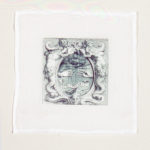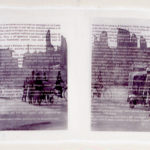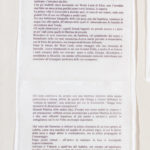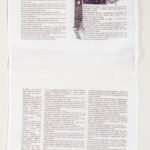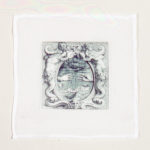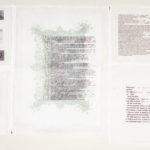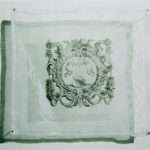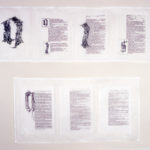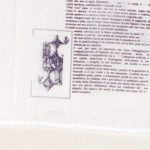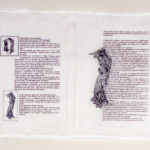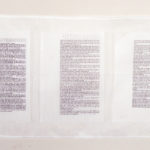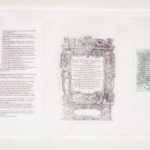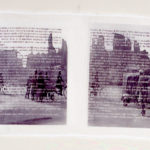
Romanzo/ Dramma 2002
- wp_7961204
- 0
- on Apr 13, 2017
Dramma
Drame/drama.The amorous subject cannot write his love story himself. Only a very archaic form can accommodate the event wich he declaims without being able to recount. (Roland Barthes, A lover’s discourse)
Words, words, words, a fiction to look at but not a broadcasted one though. It is a romance printed on a white light canvas, so thin that you can read through it, since, after few seconds, you realize that those little signs – normally used for writing – come into sight inverted.As
to being all in a sudden on the wrong side, the sign ‘ECNALUBMA’/ AMBULANCE – written in red in front of the emergency vehicles – comes to mind along with the discomfort of reading something backwards when its meaning is already known. In front of us we have a real romance, a story with characters and situations. A love story.The story of a virtual love. A love as many others, to daydream of, to be lived only in lovers’ fantasy.The same condition it underlines by means of its emotional transfers: as the longing for a love dreamed but never experienced; the kisses and the caresses we dared neither to give nor to receive; the ‘smile she never had but you wanted her to make’.
Millions of people commute daily from home to work; to whom has never happened to get deeply lost in his/her travel mate eyes, or to brush somebody’s hand and being for an instant in a paradise of his/her own? While the ‘other’ is not even aware of it.Perhaps we fall in love almost daily.
Our sentimental life – either real or virtual – is governed by situations so futile that they be incorporated into writing only thanks to an highly cultural effort, resulting in the description of some quite banal circumstances:‘I met X ……he was withY’;‘Today X ….hasn’t called me yet ’; ‘X….was in a bad mood’; etc., etc. ……..
M.G. writes about, pages and shows ‘The Lover’ in a precise sequence but under his/her
point of view, in the realm of the un-intelligible and the shifted emotions. At the centre of the context, in a space where aphasia coexists with a strongly evocative emotion.
The time of the temporal absence is presented again to enclose us in a glass-box from which we can imagine the outer world, almost seeing it living and pulsing on the other side, without the actual chance to live it. Few steps away from the edge, on the border between the factitious and the real.
A semi-opened window represents the limit, put forward repeatedly with an obsessive determination by means of a sequence of projected photographs.
Images suggesting slight, almost undetectable, movements – from- her window, the ……
The window as a connecting device between ‘the inner & the outer’, as a border between her everyday life and her ‘other’ self, elated with the desire to cross the dividing line between us and the rest of the world
Romanzo / Dramma
DRAMMA
Il soggetto amoroso non può scrivere egli stesso il suo romanzo d’amore. Solo una forma molto arcaica potrebbe raccogliere il fatto che lui declama senza poterlo raccontare.
( R. Barthes, Frammenti di un discorso amoroso))
Parole parole parole, un romanzo da guardare, ma non è una fiction televisiva. E’ un romanzo stampato su tela bianca e leggera, tanto leggera da poter permettere la lettura in trasparenza, poichè bastano pochi secondi per accorgersi che quei piccoli segni che vengono abitualmente usati per scrivere appaiono a prima vista rovesciati. Ci si trova dalla parte sbagliata. Immediatamente viene da pensare alla scritta in rosso che campeggia sul cofano anteriore delle ambulanze, ” aznalubma” ed al senso di fastidio che dà leggere leggere quella scritta pur sapendo benissimo di cosa si tratta.
Il romanzo che ci troviamo di fronte è vero, cioè una storia con personaggi e situazioni. Una storia d’amore. Un amore virtuale. Un amore come tanti che viene consumato solo nella fantasia. La stessa condizione che sottolinea, per mezzo del suo transfert emozionale, la malinconia di un’amore sognato ma non avuto, di baci e tenerezze ” che non si è osato dare” nè ricevere. Del “sorriso che non ti ha fatto ma che tu le hai deciso”.
Sono milioni le persone che si spostano giornalmente da casa per lavoro, a chi non è successo di perdersi profondamente negli “occhi della compagna di viaggio” o di sfiorare una mano quasi inavvertitamente e per un istante sentirsi in un paradiso tutto suo. E magari l’altro nemmeno se ne accorge. Forse ci s’innamora tutti i giorni, o quasi.
Le situazioni che determinano la vita amorosa, anche quella virtuale, sono talmente futili che rientrano nella scrittura solo grazie ad uno sforzo elevato, con il risultato di soffermarsi a puntualizzare situazioni alquanto banali: < Ho incontrato X… in compagnia di Y…>, < Oggi X… non mi ha telefonato>, X… era di cattivo umore >, ecc…
Marina Gasparini scrive, impagina ed espone in precisa sequenza ” il soggetto amoroso” ma ci pone nella sua identica condizione, nel luogo dell’indecifrabilità, o dello spostamento emozionale. Nel luogo della fatica della difficoltà enunciativa, ma allo stesso tempo centro del contesto, nello spazio di un’emozione fortemente evocativa. Ripropone il tempo dell’assenza temporale e ci costringe a stare dentro una scatola di vetro da cui è possibile intravvedere ed immaginare il mondo che pulsa dall’altra parte ma senza poterlo vivere direttamente. A due passi dal confine, sul limite che corre tra realtà e finzione.
Il limite che può essere rappresentato da una finestra socchiusa e riproposta con tenacia ossessiva per mezzo di immagini fotografiche proiettate in sequenza, immagini che suggeriscono lievi spostamenti, quasi impercettibili, la sua finestra, una finestra… La finestra come mezzo di collegamento fra il dentro e il fuori, come confine fra la propria vita quotidiana e l’altro da se, inebriante desiderio di valicare il limite che ci divide dal resto del mondo.
Antonio D’Orazio
Ottobre 2002
Dramma-romanzo 2001-2002
Racconto in copia unica, stampa digitale su organza, cuciture in seta.
One copy tale on fabric and silk, installation.
Villa serena Expo Art Space, Bologna, 2002

